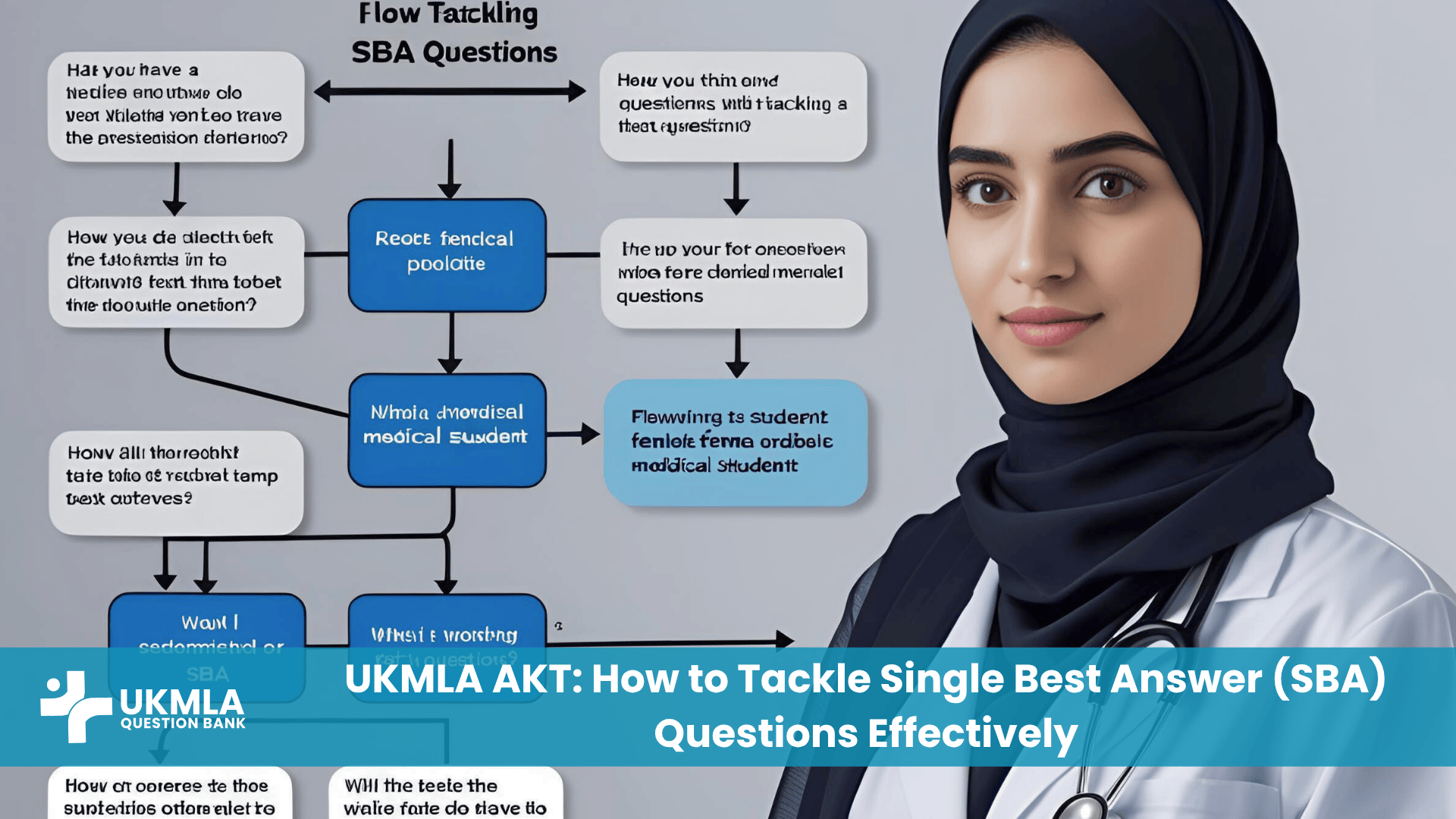The UKMLA Applied Knowledge Test (AKT) is the cornerstone of the medical licensing process in the UK, and at its heart lies a specific challenge: the Single Best Answer (SBA) question. While multiple-choice questions may seem straightforward, the UKMLA AKT SBA questions are meticulously crafted to test not just your knowledge, but your clinical reasoning, diagnostic acumen, and ability to make decisions under pressure. Simply knowing the facts is not enough; you must be able to apply them to nuanced clinical vignettes and select the single best option among several plausible choices.
This guide is dedicated to helping you tackle SBA questions effectively. We will dissect the structure of a typical UKMLA AKT SBA question, provide a systematic approach to breaking down clinical scenarios, and share advanced strategies for navigating the most challenging questions. Mastering the art of the SBA is a critical skill that can significantly elevate your performance on the UKMLA AKT. By developing a robust technique, you can turn this question format from a source of anxiety into an opportunity to showcase your clinical competence.
Key Takeaways
Before we delve into detailed strategies, here are the core principles for mastering UKMLA AKT SBA questions:
Deconstruct the Question: Break down every SBA into its core components: the clinical stem, the lead-in question, and the options.
Identify the True Question: Pinpoint exactly what is being asked before analyzing the clinical details.
Highlight Key Information: Actively identify positive and negative keywords, patient demographics, and critical clinical findings in the stem.
Anticipate the Answer: Try to formulate an answer in your mind before looking at the options to avoid being swayed by distractors.
Eliminate Incorrect Options: Systematically rule out options that are clearly wrong to narrow down your choices.
Beware of Distractors: Recognize common traps, such as options that are true but irrelevant or partially correct.
Practice is Paramount: The only way to master the SBA question format is through consistent practice with high-quality question banks.
Analyze Your Mistakes: Learning why you got a question wrong is more valuable than simply knowing the right answer.
The Anatomy of a UKMLA AKT SBA Question
To tackle SBA questions effectively, you must first understand their structure. Every UKMLA AKT SBA question is composed of distinct parts, each with a specific purpose designed to test your clinical reasoning.
The Clinical Stem: Setting the Scene
The stem is the clinical scenario or vignette that provides the context for the question. It typically includes:
Patient Demographics: Age, sex, and sometimes occupation or social context.
Presenting Complaint: The main reason the patient is seeking medical attention.
History: Details about the presenting complaint, past medical history, medications, allergies, and family or social history.
Examination Findings: Vital signs and relevant physical examination results.
Investigation Results: Laboratory data, imaging results (e.g., X-ray, ECG), or other diagnostic findings.
The content for these stems is drawn from the official UKMLA blueprint, which you can find more information about through the GMC UKMLA guidance. Your first task is to read the stem carefully, absorbing the key details that will help you solve the clinical puzzle.
The Lead-In: Asking the Specific Question
The lead-in is the direct question that follows the stem. It is arguably the most important part of the entire SBA. It tells you precisely what your task is. Common lead-in questions include:
“What is the most likely diagnosis?”
“What is the most appropriate initial investigation?”
“What is the most appropriate next step in management?”
“Which of the following is the most likely causative organism?”
“What is the mechanism of action of the most appropriate treatment?”
Highlight: Always read the lead-in question before you deeply analyze the stem. Knowing what you’re looking for helps you focus on the most relevant information in the clinical vignette.
The Options: Navigating Choices and Distractors
Finally, you are presented with a set of options, typically five. In an SBA, the design is sophisticated:
The Correct Answer: The single best option that directly and most accurately answers the lead-in question based on the stem.
Plausible Distractors: These are options that might be partially correct, correct but for a different clinical situation, or true statements that do not answer the specific question. They are designed to trap candidates who have incomplete knowledge or who misinterpret the question.
Clearly Incorrect Options: There may be one or two options that are definitively wrong, which can often be eliminated quickly.
Understanding that some options are designed to be “almost right” is crucial for developing a cautious and analytical approach to every UKMLA AKT SBA question.
A Step-by-Step Strategy to Deconstruct SBA Questions
Having a systematic approach can prevent panic and reduce errors. Follow these steps for every UKMLA AKT SBA question you encounter to improve your accuracy and efficiency.
Step 1: Read the Lead-In Question First
Before getting lost in the details of the clinical scenario, identify your mission. Read the lead-in question. Are you being asked for a diagnosis, an investigation, or a management step? Knowing this focuses your reading of the stem and prevents you from going down the wrong analytical path. This is the foundational step to tackle SBA questions effectively.
Step 2: Analyze the Stem and Highlight Keywords
Now, read the clinical stem with your mission in mind. Actively highlight or underline the keywords. Pay close attention to:
Age and Sex: These can be major clues (e.g., conditions common in elderly women).
Buzzwords: Classic descriptors of conditions (e.g., “tearing” chest pain for aortic dissection).
Positive Findings: Key symptoms, signs, or investigation results that point towards a diagnosis.
Negative Findings: The absence of certain signs or symptoms can be just as important for ruling out differential diagnoses.
Timeline: Acute vs. chronic presentation is a critical differentiator.
This active reading process helps you filter out noise and focus on the data that truly matters.
Step 3: Formulate Your Own Answer Before Looking at the Options
Based on your analysis of the stem and lead-in, try to predict the answer. If the question asks for the most likely diagnosis, what is your top differential? If it asks for the next step in management, what would you do in practice?
This pre-formulation step helps you avoid being tempted by well-written but incorrect distractors. You enter the options phase with a clear idea, looking for the choice that matches your clinical judgment. This technique is at the heart of why “Why UKMLA MCQs Are Crucial For Your Medical Career Success” is a must-read for candidates.
Step | Action | Rationale for Tackling SBAs |
|---|---|---|
1 | Read the lead-in question first. | Defines your task and focuses your analysis of the clinical stem. |
2 | Analyze the stem and highlight keywords. | Helps you extract the most relevant clinical data efficiently. |
3 | Formulate an answer before viewing options. | Prevents you from being biased or confused by plausible distractors. |
4 | Systematically evaluate and eliminate options. | Narrows the field and increases your probability of selecting the correct answer. |
Advanced Techniques for Answering Tricky SBA Questions
Some UKMLA AKT SBA questions are designed to be particularly challenging. Here are some advanced strategies for when the answer isn’t immediately obvious.
Dealing with the “Two Best Answers” Dilemma
A common challenge is facing two options that both seem correct. When this happens, you must return to the lead-in question and the stem to find the deciding factor. Ask yourself:
Which option is most appropriate? ne might be a definitive treatment while the other is supportive. When in doubt, consulting national recommendations like the NICE guidelines during your study can help you understand these distinctions.
Which step comes first? The question might ask for the initial step, and both options might be valid, but one precedes the other.
Is there a contraindication? Does the patient’s history (e.g., allergy, renal failure) make one of the otherwise correct options unsafe?
Is there a subtle keyword you missed? Re-read the stem for a small detail that makes one option superior.
This is where true clinical reasoning is tested. The exam is called “Single Best Answer” for a reason—your job is to identify the nuance that makes one option better than the other.
Navigating Positively and Negatively Skewed Questions
Most questions are positively skewed (“What is the most appropriate…”). However, you may encounter negatively skewed questions, which can be tricky if you’re reading too quickly. These use words like:
“Which of the following is the least likely diagnosis?”
“Which investigation is not indicated?”
“All of the following are appropriate treatments except…”
Highlight: When you see a negatively skewed question, slow down. Your brain is conditioned to look for the correct answer. You must consciously invert your thinking to look for the incorrect or least appropriate option. A good strategy is to go through the options and identify the four that are correct, leaving you with the one that is the exception.
Using the Process of Elimination Wisely
The process of elimination is your most powerful tool when you are uncertain. Even if you cannot identify the correct answer immediately, you can often identify one or two that are clearly wrong.
Eliminate based on absolute contraindications.
Eliminate options that are irrelevant to the clinical scenario.
Eliminate options that are too invasive or too slow for an acute situation.
Even narrowing the field from five options to three significantly increases your chances of selecting the correct answer. > “In the world of single-best-answer questions, the path to the right answer is often paved by eliminating the wrong ones.” – (Attributed to a medical education expert).
SBA Challenge | Strategy | Example |
|---|---|---|
Two seemingly correct answers | Re-read the lead-in for qualifiers like “initial” or “definitive.” Scrutinize the stem for subtle clues or contraindications. | For acute asthma, both salbutamol and steroids are correct treatments, but salbutamol is the most appropriate initial step. |
Negatively skewed question | Identify the four correct options to find the one that is the exception. Slow down and consciously invert your thinking. | “All are features of hyperthyroidism EXCEPT…” – find the four that are, and the one remaining is the answer. |
Unfamiliar topic | Use the process of elimination. Rule out options you know are incorrect based on general medical principles (e.g., safety, invasiveness). | Even without knowing the exact diagnosis, you can rule out giving a nephrotoxic drug to a patient with known renal failure. |
The Role of Practice and Analysis in Mastering the SBA Format
You cannot learn to tackle SBA questions effectively by reading alone. Success comes from active, repeated practice and meticulous analysis of your performance.
Why High-Quality Question Banks Are Essential
High-quality UKMLA AKT question banks are the single most important resource for preparing for SBAs. They allow you to:
Familiarize yourself with the question style: The more SBAs you see, the more you understand their structure and common tricks.
Test your knowledge application: They force you to apply what you’ve learned to clinical scenarios.
Improve your timing: Practicing under timed conditions helps you develop a rhythm and pace for the real exam.
Identify knowledge gaps: Your performance will clearly show which topics you need to revisit.
Our guide, “Conquer the UKMLA: Your Guide to Effective Practice Questions,” offers more insight into making the most of your practice sessions.
The Power of Meticulous Performance Analysis
Simply doing questions is not enough. The most critical learning happens after you answer. For every question, whether you got it right or wrong, you must:
Read the explanation thoroughly.
Understand why the correct answer is the BEST answer.
Understand why every other option is INCORRECT.
If you got a question wrong, diagnose the reason. Was it a knowledge gap? Did you misread the question? Were you tricked by a distractor? Keeping a log of your errors can reveal patterns and help you address your specific weaknesses.
Avoiding Common SBA Pitfalls and Mistakes
Through practice and analysis, you’ll start to recognize common mistakes that candidates make. These include:
Not reading the lead-in question carefully.
Getting bogged down by irrelevant details in the stem.
Choosing an option that is “true but not the answer.”
Second-guessing yourself and changing a correct answer.
Spending too much time on a single difficult question.
Recognizing these pitfalls is the first step to avoiding them. Our article on “UKMLA Mistakes to Avoid: Your Ultimate Guide to Improving Your Score in 2025” provides a deeper look into common errors and how to overcome them.
Frequently Asked Questions (FAQ) About UKMLA SBA Questions Answered
This depends on the total number of questions and the time allotted for the exam. Generally, you will have around 90 seconds to 2 minutes per question. It’s crucial to practice under timed conditions to find a comfortable pace.
The UKMLA AKT typically does not use negative marking. Therefore, you should always select an answer. Use the process of elimination to make an educated guess; never leave a question blank.
It’s essential to have a “move on” strategy. If a question is consuming too much time, make your best-educated guess, flag it for review, and move on. You can come back at the end if you have time. Don’t sacrifice several easier questions for one difficult one.
The options are designed to be challenging and to differentiate between candidates with deep understanding and those with superficial knowledge. They are “distractors,” not intentionally misleading in a malicious way. They test your ability to identify the single best answer among plausible alternatives.
Often, your initial instinct, born from hundreds of hours of study and clinical experience, is correct. However, this should be balanced with a systematic approach. If your gut feeling conflicts with your analytical breakdown of the question, re-read the stem and lead-in carefully to see what you might have missed.
Approach them the same way, but treat the image as part of the clinical stem. Analyze the image systematically (e.g., for an ECG, check rate, rhythm, axis, etc.) before reading the rest of the stem. Let your findings from the image become part of the keywords you use to solve the problem.
By definition, the SBA format requires a single best answer. While other options might have some element of truth, one will be demonstrably superior based on current guidelines, the acuity of the situation, or a specific detail in the vignette.
While you generally won’t be asked to recall obscure dosages, you are expected to know common ones (e.g., adrenaline in anaphylaxis). For lab values, reference ranges are usually provided, but you need to know the clinical significance of values being high or low.
While any practice is better than none, it is most effective to use resources specifically designed for the UKMLA AKT. This is because the question style, emphasis on certain topics, and use of UK-based guidelines and terminology will be most accurate.
Speed comes from practice and developing a reliable system. The more you use the systematic approach outlined above, the faster and more second-nature it will become. Timed practice sessions are essential for building both speed and stamina.
Conclusion: Mastering the SBA is Mastering the UKMLA AKT
The Single Best Answer question is more than just a testing format; it is a simulation of clinical decision-making. Learning to tackle SBA questions effectively is a skill that mirrors the process of becoming a competent and safe doctor: gathering information, identifying the core problem, considering possibilities, and committing to the best course of action. The strategies discussed here—from deconstructing the question to meticulous practice and analysis—are designed to build that skill.
By adopting a systematic approach, you can navigate the complexities of the UKMLA AKT with confidence. Treat every practice question as an opportunity to refine your technique. With persistence and the right strategy, you can master the SBA question format and take a significant step towards achieving your goal of practicing medicine in the UK.



